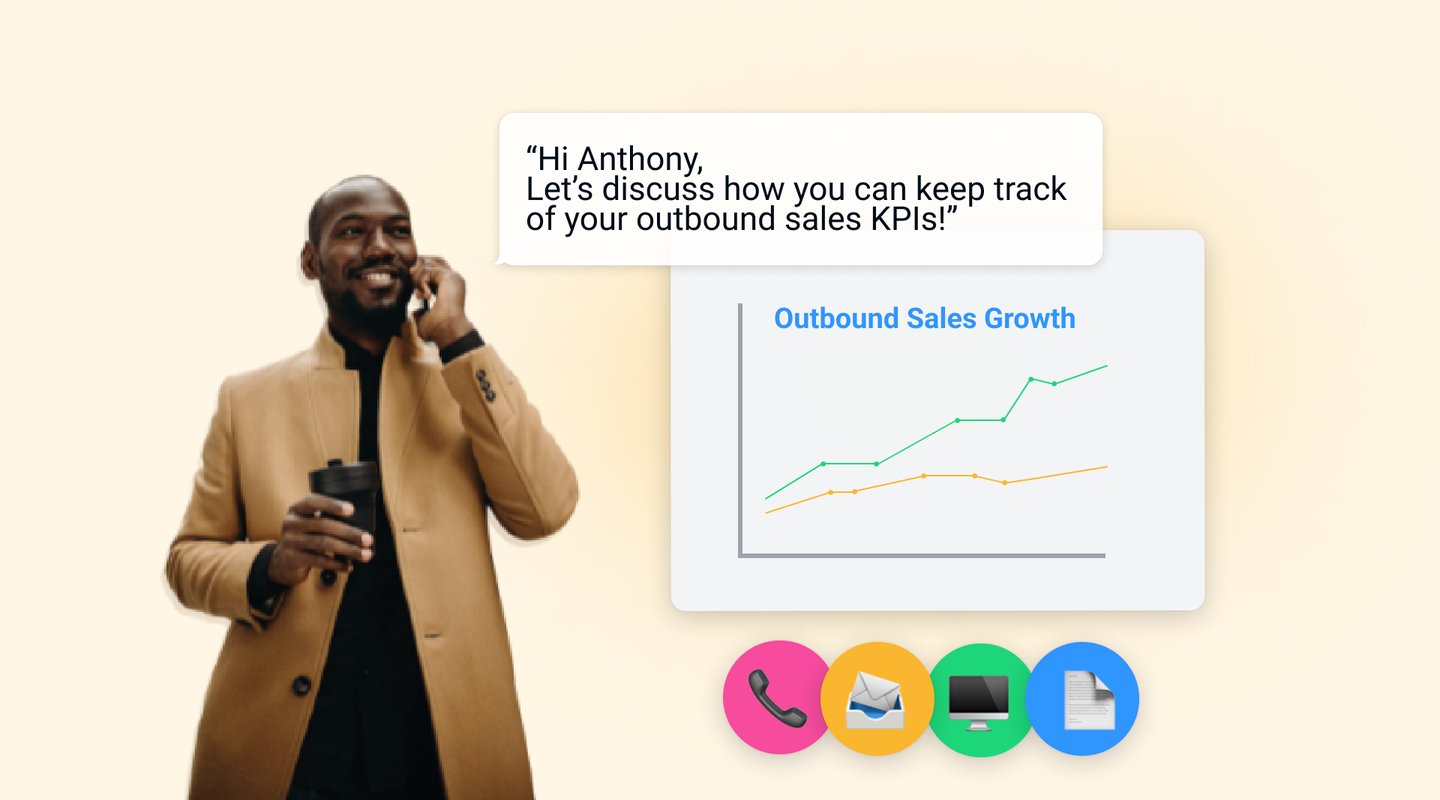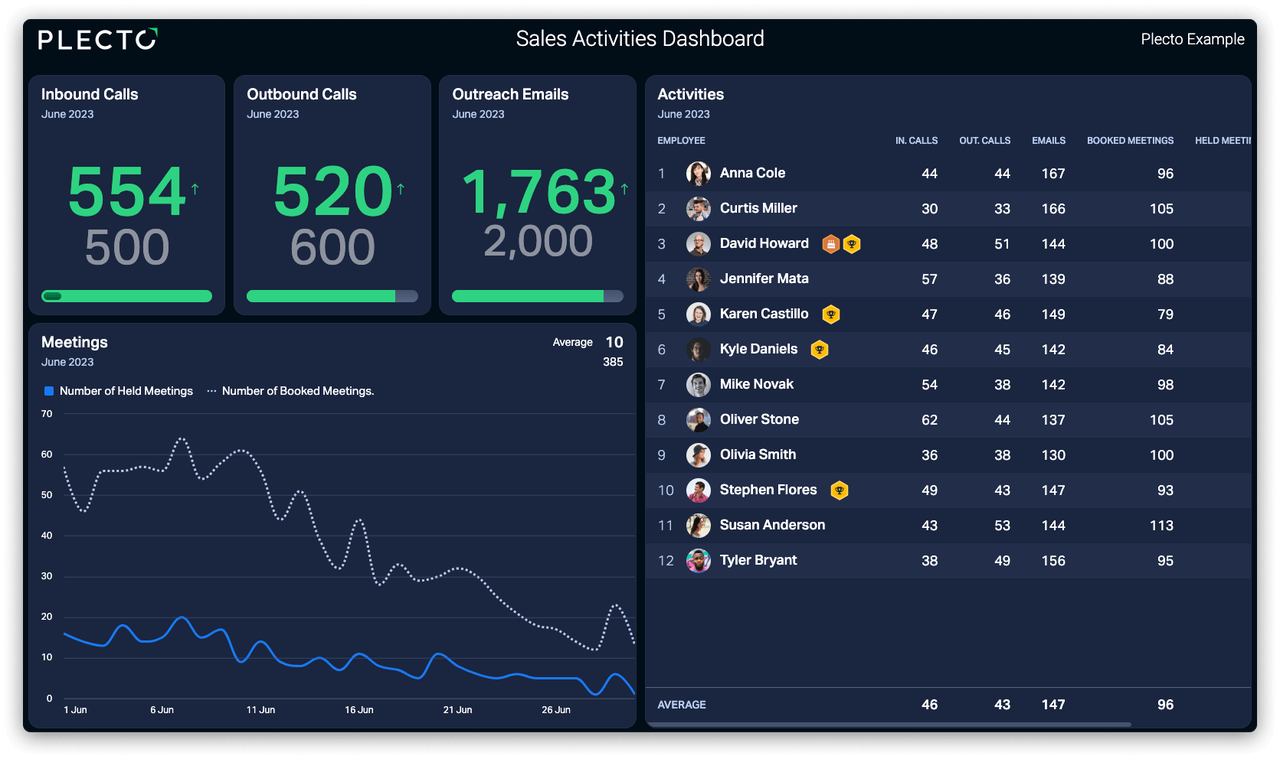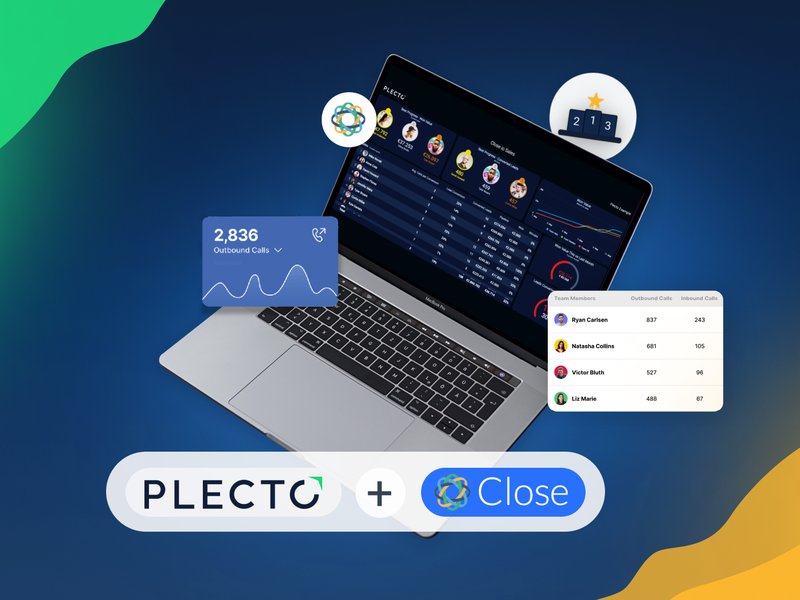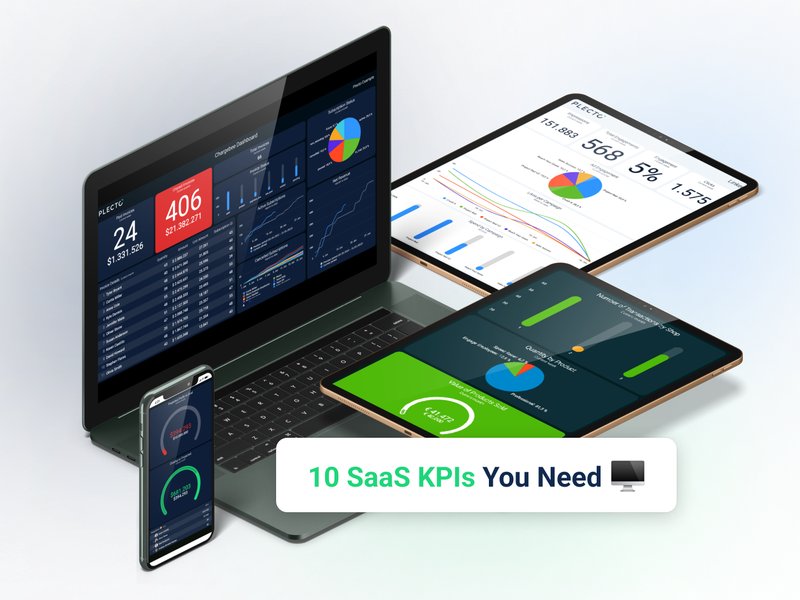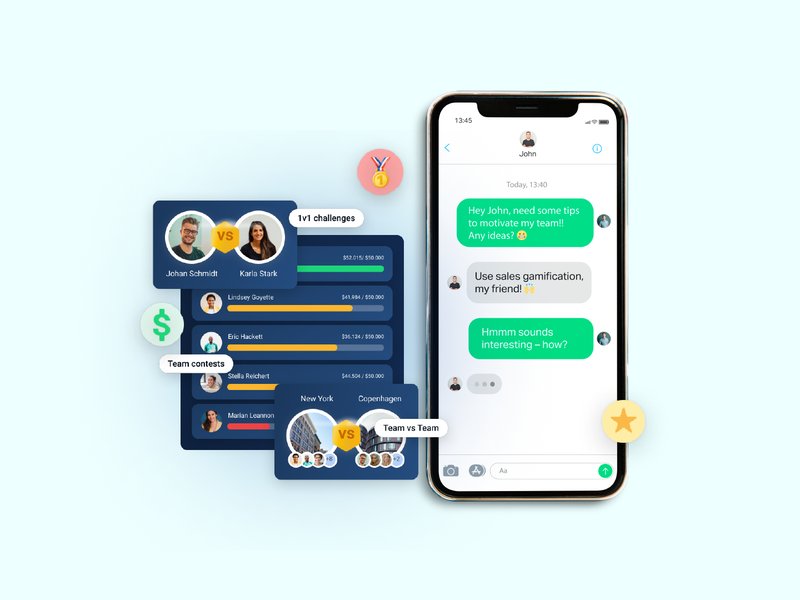There’s no doubt that the internet has changed the way people shop and buy. In response, many sales organizations have pivoted to inbound sales strategies. But that doesn’t mean that outbound sales is dead. Outbound sales has been the foundation of sales organizations for decades, and with good reason – it works.
Data is the key differentiator in traditional outbound sales strategies vs. today’s more modern approach. Whether an organization focuses on inbound sales, outbound sales, or a combination of the two, the most successful sales organizations are becoming increasingly data-driven. Sales KPIs are crucial to this approach because they can help sales leaders understand which sales activities yield the best results and where they could improve.
This article will help you understand how to fine-tune your outbound sales methodology. Discover which outbound sales KPIs you should be tracking, and how to optimize your outbound strategy to ensure your outbound sales representatives are focusing on the right activities.
But first, what is outbound sales?
Outbound sales is probably what comes to mind when you think of ‘sales.’ It is generally considered the more traditional sales methodology but has been adapted to suit more modern systems and behaviors. Outbound sales is a sales approach in which sales representatives generate leads, contact prospects typically via cold calls or cold emails, build relationships, and deliver a pitch with the intent of securing a deal. Modern outbound sales techniques also include emails, social selling, live chat, and paid online advertising.
The key difference between inbound and outbound sales is who instigates the relationship. Outbound sales representatives are responsible for contacting leads in an outbound sales strategy. Conversely, inbound sales waits for prospects to make the first move and reach out to the company offering the product or service. In these organizations, it is perhaps the marketing team’s responsibility to generate leads. The sales reps’ main task is to help prospective customers understand how a particular solution can ease their pain points and why it’s the best choice.
Curious to learn about inbound sales? Check out our previous article that covers everything you need to know about implementing an inbound sales strategy.
Outbound sales enables you to target the types of customers your company wants. One approach isn’t necessarily better than the other — rather, a mix of inbound and outbound sales is the perfect cocktail for increasing overall revenue. After all, when has it ever been a good idea to put all of your eggs in one basket?
What does a successful outbound sales strategy look like?
In today’s buyer-driven internet sales environment, there’s a lot that outbound sales teams can learn from successful inbound sales strategies.
One of the most insightful takeaways is that buyers say that a positive sales experience includes the following four attributes:
- Listens to their needs (69%)
- Isn’t pushy (61%)
- Provides relevant information (61%)
- Provides timely responses (51%)
With this in mind, it’s imperative to craft an outbound sales strategy around these points. The stereotypical pushy and overly friendly approach that’s become synonymous with salespeople is a turnoff to today’s customers, and inbound sales methodologies can teach some valuable lessons in this area. We cover this in a previous article on inbound sales, which you can find here.
Once your outbound sales representatives have qualified a lead, their next job is to help the prospect understand how your company’s solution can alleviate their pain and why it’s their best choice. Like a successful inbound sales strategy, a successful outbound sales strategy is buyer-focused with an emphasis on providing information, building trust, and finding solutions. Only 13% of customers believe that a salesperson can understand their needs, so it’s more crucial than ever to listen and to make prospects feel heard and understood.
3 Ways to Modernize Your Outbound Sales Strategy
Here are three 'quick win' ways to modernize your organization's approach to outbound sales.
1–Opt for customer-centric selling
If you’re looking for long-term value, personalization is key. Research shows that phone calls are 10 times more likely to lead to sales than emails. Pick up the phone, ditch the pitch, and listen to what the prospect is telling you.
Building an open, two-way dialogue – rather than just pitching at a prospect – is a much more effective way of understanding prospects needs. Quality conversations develop more quality leads that are more likely to convert during a shorter sales cycle and provide longer customer lifetime value. Optimize your time so you spend more time on quality that will equate to greater long-term value! Not sure where to start? Here’s 4 straightforward tips to follow to have more meaningful sales interactions.
2–Ask for leads
It takes an average of eight cold call attempts to reach a prospect, but what if you could find a shortcut? Every new customer has a network, and those networks are likely to include people who might also benefit from your company’s solution. Combine that need with a word-of-mouth endorsement from your newest customer, and most of the legwork has been done. Statistically, referral leads have a higher close rate than leads found through other avenues. If you’re not quite sure how to ask for a referral, this article can help.
3–Develop your cold call script library
Why reinvent the wheel? Most top-performing outbound sales representatives have their phone call scripts down to a science, and use them as a foundation for cold calling success. A common misconception is that cold calls are completely scripted, oftentimes coming across as ingenuine and dry. Change the narrative and spice your scripts – do your research, personalize your dialogue, add in some personality or humor where suitable. For a more structured approach, perform A/B tests to see what works best with each potential customer segment. Once you’ve honed your messaging, you’ll be able to train new reps more efficiently and get them to close deals more quickly!

Why are outbound sales KPIs important?
Before we dive into the outbound sales KPIs examples, let’s talk about why outbound sales KPIs even matter.
Outbound sales KPIs go beyond metrics, like the number of meetings set and new business revenue, to help sales leaders and their teams understand how well their activities and processes are working. When your outbound sales representatives focus their attention on low-yield activities, your company loses money. Once you understand what works, what doesn’t, and why, you can develop an outbound sales process that produces predictable revenue-producing results quarter after quarter.
To get the most out of your outbound sales KPIs, focus on a handful that directly measure your team’s outbound sales activities – and their results. Over time, these outbound sales KPIs will help you understand which activities result in the most revenue, so you can adjust course if necessary.
If you decide to integrate KPIs into your sales methodology (and you should), go all in by giving each stakeholder access to the right data, preferably in a visual format – like charts and graphs – on data dashboards. The right data in an easy-to-understand way will empower your team to track their results, optimize their efforts, and focus their attention on the activities that bring the best results.
10 Outbound Sales KPIs to Track
Following are 10 outbound sales KPIs you should be tracking. They include a mix of top-level, tactical, and operational metrics:
👉 Top-level KPIs can be a good indicator of how your department or company is performing overall. These higher-level metrics showcase the broader result of your outbound sales representatives' efforts.
👉 Tactical KPIs measure how well your current activities are driving business.
👉Operational KPIs monitor and evaluate the efficiency of your daily operations to help you understand which processes are effective and which could be improved.
To get an overview of how your organization is performing and identify areas where you could improve, choose a mix of outbound sales KPIs to track from each category. It’s not unusual to focus on operational and tactical KPIs instead of top-level KPIs. Your main objective when choosing which outbound sales KPIs to track is to see where your sales process and performance excel and where improvements could be made.
If you’re new to tracking outbound sales KPIs, these 10 outbound sales KPIs examples are a great place to start!
1. New Business Revenue (Top-Level)
Outbound sales teams exist to discover new customers and generate revenue. That’s why we’ve put ‘new business revenue’ at the top of the list. This KPI tracks how much income your outbound sales team is generating from first-time buyers. It’s a solid barometer of how well your outbound sales machine is functioning.
We recommend tracking new business revenue monthly against a target percentage (e.g., 30% of revenue should come from first-time buyers). If your team isn’t hitting this target, consider doing a deep dive into your outbound sales processes to identify areas that could be improved.
2. Projected Pipeline Sales Value (Top-Level)
Projected pipeline sales value measures how much the projected deals in your sales funnel are worth. It’s an excellent snapshot of the the sales cycle, which can help you make informed decisions about which activities the team should focus on in the short term. A full pipeline could indicate that it’s time to back off on generating new leads and focus instead on closing deals before the leads go cold.
You can use this formula to calculate your projected pipeline value:
Projected Pipeline Sales Value = Deal Value x Probability of Closing
We recommend tracking this KPI monthly as a monetary amount of potential revenue expected to close within a specific timeframe (e.g., $250,000 within the next 6 weeks).
3. Outbound Sales Growth (Top-Level)
This metric is directly tied to revenue and profitability, so it’s a fantastic way to check the pulse of your current processes. Outbound sales growth quantifies your outbound sales representatives’ ability to increase revenue over a specified period. Outbound sales growth can be an early indicator that not enough qualified leads are being generated, not enough leads are converting, or the average deal size is too small.
You can use this formula to calculate your outbound sales growth over a specified period:
Outbound Sales Growth = (Current Period Sales (Outbound) - Outbound Sales During Past Period) / Outbound Sales During Past Period
At a minimum, we recommend tracking this KPI monthly – but don’t forget to keep eye on how your outbound revenue is tracking against your quarterly and annual goals.
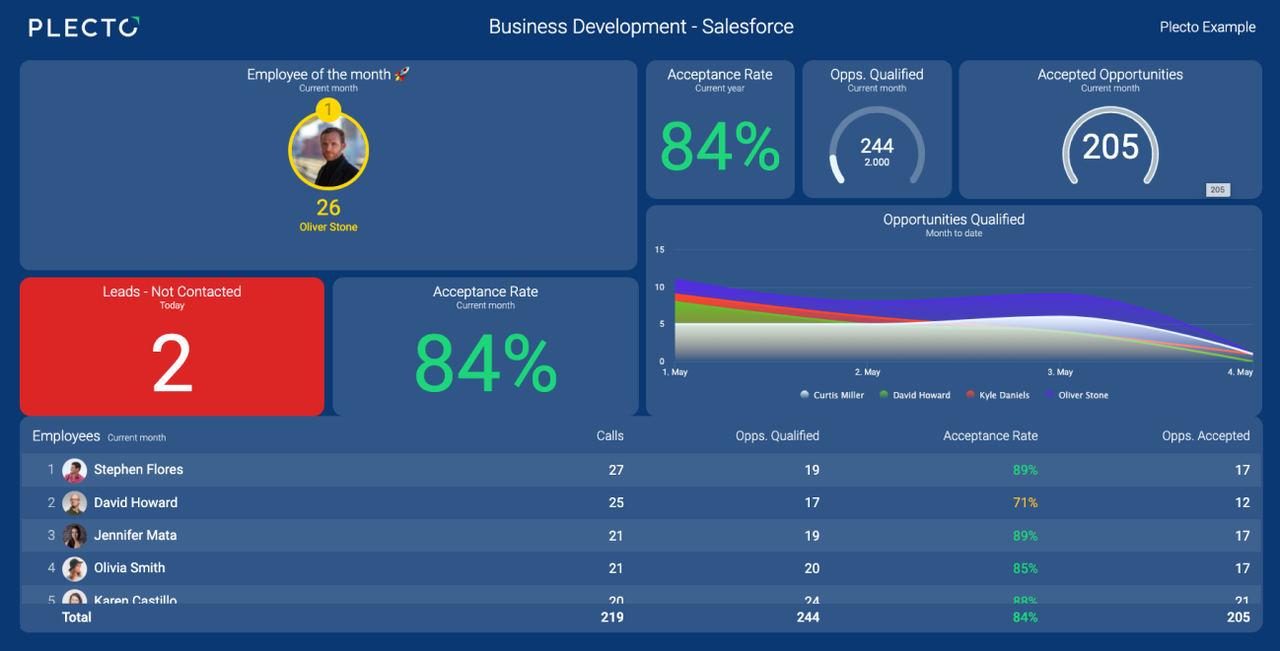
4. Phone Calls (Operational)
Cold calling is a crucial top-of-funnel activity that has long been the bread and butter of outbound sales. While this prospecting method is largely a numbers game, measuring the true impact of your reps’ phone time goes well beyond how many calls they make. At the very least, you should be tracking the number of calls made. However, to get a true picture of how your team’s outbound calls are performing, consider tracking a combination of these metrics:
→ Fail Rate – No Answer / Unreachable
This basic metric separates the number of calls that resulted in 1:1 contact or reached voicemail vs. calls that were “bad numbers” or resulted in no answer. This can help you determine the quality of your phone list(s).
Fail Rate = Number of Calls Made / Number of Contacts Made
→ Response Type
Tracking all responses can help determine if your phone scripts could use further development and whether you need to improve the quality of your contact phone book. Also crucial for pipeline management, this metric can help your team keep track of positive conversations so they can follow up at the appropriate time and (hopefully) book those all-important meetings and demos.
→Appointment Rate
Effective cold calling should be driving appointments, meetings, or demos. This is an important metric because it tells you how many contacts have resulted in solid leads who have enough interest to schedule a discovery meeting.
Appointment Rate = Number of Appointments Scheduled / Number of Contacts Made x 100
→Average Call Duration
This metric can give you insights into the effectiveness and efficiency of each rep’s sales pitch. If some reps are spending a lot of time on the phone without converting, it could be time to schedule some training. Conversely, if you see other reps hitting their targets while spending less time on the phone, you might want to take a closer look at how they pitch and perhaps have them share it with the rest of the team.

5. Emails (Operational)
At a minimum, you should be tracking the number of emails your outbound sales representatives send. However, that’s only a snippet of the overall channel. To get a solid overview of how your outbound email process is performing, consider tracking a combination of these metrics:
→ Bounce Rate
This basic metric shows how many emails were actually delivered, which can help you ascertain the quality of your email list(s).
Bounce Rate = Number of Emails Bounced / Number of Emails Sent x 100
→ Open Rate
This metric will help you understand things like whether you’re using the right subject and snippet messaging and whether you’re targeting the right people.
Open Rate = Number of Emails Opened / Number of Emails Delivered x 100
→ Response Rate
Responses are why you’re sending emails in the first place, so make sure your team is seeing a return on their time and effort.
Response Rate = Prospect Responses / Number of Emails Opened x 100
→ Appointment Rate
Opens and responses are only useful if they convert to a sale. Appointment rate is the most insightful email metric because it tells you how many of your team’s emails have resulted in a solid foot in the door – a discovery meeting.
Appointment Rate = Number of Appointments Scheduled / Number of Prospects Contacted x 100
6. Outbound Conversion Rate (Tactical)
Outbound conversion rate tracks the percentage of outbound leads that convert to qualified appointments. This KPI measures one step beyond the ‘appointment rate’ metrics mentioned above by focusing on the meeting that comes after the discovery meeting – the meeting where the qualified lead becomes a solid prospect. It’s one of the most accurate indicators of how your lead generation and pipeline are performing.
To get the most out of this KPI, measure the conversion rate for each of your outbound channels (e.g., cold calls, emails, live chat). This will help you identify where to focus your efforts for the highest return. Use the following formula to calculate the conversion rate:
Close Ratio = Number of Closed Deals ÷ Total Lead Opportunities x 100
The close ratio can be used to validate other inbound sales KPIs. For example, if your average response time is lightning-fast and your follow-up percentage is at or near 100% but your close ratio is lagging, it’s time to look at your sales process and messaging. Is your content library up to scratch? Is your email messaging on-point? Are your inbound sales representatives using value-based selling? Try to identify the weak spots in your process and see what you can do to fix them.
7. Number of Offers Sent (Operational)
As a result of measuring and acting on the phone and email metrics we’ve covered above, your phone and email processes should be driving appointments and demos. If your outbound sales representatives are on point, the next step should be sending an offer. Comparing the number of offers sent with your conversion rates for a specified period will give you a pretty clear indication of whether your team is qualifying the right leads, delivering the right pitch, and providing the right consultation to potential customers.
You can use this formula to calculate the average conversion rate:
Offer Rate = Number of Offers Sent / Number of Appointments Scheduled x 100
Build your first dashboard.
Start your 14-day free trial today
8. Hit Rate (Tactical)
Hit rate is a customizable KPI that can measure the percentage of emails, calls, meetings, or other activities that turn into sales. It can be a “work smarter, not harder” KPI. Taking the time to prospect high-quality leads can pay off with a higher hit rate vs. casting a wide net and seeing what you catch. This metric can give you beneficial insights into return on effort. You can use this formula to calculate your hit rate:Hit Rate = Number of Sales / Number of Specified Activity (e.g., calls, emails) x 100
9. Outbound Customer Acquisition Cost (Tactical)
Running an outbound sales team costs money – and acquiring new customers can be expensive. These costs directly affect your company’s profitability, but do you actually know how much it costs to acquire a new customer? This KPI can help you track outbound sales ROI and identify places needing adjustment. If cold-calling isn’t working, maybe it’s time to focus on social media campaigns or inbound sales. Keeping a close eye on customer acquisition costs will help you nip negative trends in the bud – and identify and leverage positive trends.
You can use this formula to calculate your outbound customer acquisition cost (CAC):
CAC = Total Cost of Outbound Sales / Number of Customers Acquired
10. Customer Lifetime Value (Tactical)
Customer lifetime value (CLV) predicts the total profit a customer will produce during the entire time they do business with your company. Tracking CLV alongside CAC can help you keep costs in check. You should be aiming for a CLV that’s at least three times your CAC (i.e., CLV:CAC = 3:1)
You can use this formula to calculate your CLV:
CLV = Customer Revenue Per Year x Average Retention Time - CAC
This KPI can help identify the types of leads your sales reps should be pursuing. Bigger deals with higher lifetime values result in lower operational costs and higher profits. Understanding these customers’ key attributes can help your sales reps identify and focus on prospects with the highest ROI potential so they can close the right deals.

Want even more sales KPIs?
If we’ve piqued your interest in using data to fine-tune your outbound sales process, you might enjoy this article, which includes another 21 sales KPIs examples. And if you’d like to take it company-wide, look here for 100 more marketing, support, finance, development, and sales KPIs examples that will get your whole company on the data-driven road to success!
Data-Driven Sales Need Great Tracking
We’ve given you 10 actionable outbound sales KPIs to track, which is a great first step. But to drive performance, you have to actively track your KPIs – and act on them! Get the most out of your data by visualizing and sharing the most valuable KPIs on data dashboards.
Plecto integrates with most major sales-tracking software and allows you to customize your KPIs and visualize them in real-time! Incorporate performance-driven gamification features like contests and instant notifications that spark friendly competition and drive motivation to outperform on crucial KPIs for your business performance success.
Sign up for a FREE 14-day Plecto trial and see for yourself how visualizing these outbound sales KPIs are the key to boosting high-value sales in less time! 🚀
